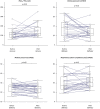Management and outcomes of pregnant women admitted to intensive care unit for severe pneumonia related to SARS-CoV-2 infection: the multicenter and international COVIDPREG study
- PMID: 35978137
- PMCID: PMC9383668
- DOI: 10.1007/s00134-022-06833-8
Management and outcomes of pregnant women admitted to intensive care unit for severe pneumonia related to SARS-CoV-2 infection: the multicenter and international COVIDPREG study
Abstract
Purpose: Management and outcomes of pregnant women with coronavirus disease 2019 (COVID-19) admitted to intensive care unit (ICU) remain to be investigated.
Methods: A retrospective multicenter study conducted in 32 ICUs in France, Belgium and Switzerland. Maternal management as well as maternal and neonatal outcomes were reported.
Results: Among the 187 pregnant women with COVID-19 (33 ± 6 years old and 28 ± 7 weeks' gestation), 76 (41%) were obese, 12 (6%) had diabetes mellitus and 66 (35%) had pregnancy-related complications. Standard oxygenation, high-flow nasal oxygen therapy (HFNO) and non-invasive ventilation (NIV) were used as the only oxygenation technique in 41 (22%), 55 (29%) and 18 (10%) patients, respectively, and 73 (39%) were intubated. Overall, 72 (39%) patients required several oxygenation techniques and 15 (8%) required venovenous extracorporeal membrane oxygenation. Corticosteroids and tocilizumab were administered in 157 (84%) and 25 (13%) patients, respectively. Awake prone positioning or prone positioning was performed in 49 (26%) patients. In multivariate analysis, risk factors for intubation were obesity (cause-specific hazard ratio (CSH) 2.00, 95% CI (1.05-3.80), p = 0.03), term of pregnancy (CSH 1.07, 95% CI (1.02-1.10), per + 1 week gestation, p = 0.01), extent of computed tomography (CT) scan abnormalities > 50% (CSH 2.69, 95% CI (1.30-5.60), p < 0.01) and NIV use (CSH 2.06, 95% CI (1.09-3.90), p = 0.03). Delivery was required during ICU stay in 70 (37%) patients, mainly due to maternal respiratory worsening, and improved the driving pressure and oxygenation. Maternal and fetal/neonatal mortality rates were 1% and 4%, respectively. The rate of maternal and/or neonatal complications increased with the invasiveness of maternal respiratory support.
Conclusion: In ICU, corticosteroids, tocilizumab and prone positioning were used in few pregnant women with COVID-19. Over a third of patients were intubated and delivery improved the driving pressure.
Keywords: Acute respiratory distress syndrome; COVID-19; Mechanical ventilation; Neonates; Oxygenation; Pregnancy; Prognosis; Prone positioning.
© 2022. Springer-Verlag GmbH Germany, part of Springer Nature.
Conflict of interest statement
The authors have no conflict of interest to declare.
Figures



References
-
- Villar J, Ariff S, Gunier RB, Thiruvengadam R, Rauch S, Kholin A, et al. Maternal and neonatal morbidity and mortality among pregnant women with and without COVID-19 infection: the INTERCOVID multinational cohort study. JAMA Pediatr. 2021;175:817–826. doi: 10.1001/jamapediatrics.2021.1050. - DOI - PMC - PubMed
Publication types
MeSH terms
LinkOut - more resources
Full Text Sources
Medical
Miscellaneous

